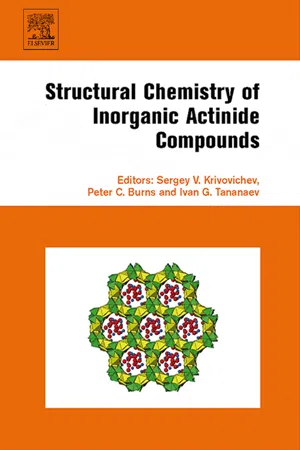
Structural Chemistry of Inorganic Actinide Compounds
- 504 pages
- English
- ePUB (mobile friendly)
- Available on iOS & Android
Structural Chemistry of Inorganic Actinide Compounds
About This Book
Structural Chemistry of Inorganic Actinide Compounds is a collection of 13 reviews on structural and coordination chemistry of actinide compounds. Within the last decade, these compounds have attracted considerable attention because of their importance for radioactive waste management, catalysis, ion-exchange and absorption applications, etc. Synthetic and natural actinide compounds are also of great environmental concern as they form as a result of alteration of spent nuclear fuel and radioactive waste under Earth surface conditions, during burn-up of nuclear fuel in reactors, represent oxidation products of uranium miles and mine tailings, etc. The actinide compounds are also of considerable interest to material scientists due to the unique electronic properties of actinides that give rise to interesting physical properties controlled by the structural architecture of respective compounds. The book provides both general overview and review of recent developments in the field, including such emergent topics as nanomaterials and nanoparticles and their relevance to the transfer of actinides under environmental conditions.* Covers over 2, 000 actinide compounds including materials, minerals and coordination polymers* Summarizes recent achievements in the field* Some chapters reveal (secret) advances made by the Soviet Union during the 'Cold war'
Frequently asked questions
Information
Crystal chemistry of uranium oxocompounds: an overview
Publisher Summary
1 Introduction
Table of contents
- Cover image
- Title page
- Table of Contents
- Foreword
- Preface
- Chapter 1: Crystal chemistry of uranium oxocompounds: an overview
- Chapter 2: Some features of stereochemistry of U(VI)
- Chapter 3: Hydrated oxides, hydroxides and peroxides of transuranium elements
- Chapter 4: Actinide compounds containing hexavalent cations of the VI group elements (S, Se, Mo, Cr, W)
- Chapter 5: Actinide compounds with heavy oxoanions containing a stereochemically active lone-pair of electrons
- Chapter 6: Crystal chemistry of actinide phosphates and arsenates
- Chapter 7: Structural chemistry of uranium vanadates: from 2-D to 3-D networks
- Chapter 8: Chemistry and structural chemistry of anhydrous tri- and tetravalent actinide orthophosphates
- Chapter 9: Structural chemistry of actinide polyoxometalates
- Chapter 10: Coordination interaction of transuranium elements with N-donor ligands
- Chapter 11: U(VI)-containing metal-organic frameworks and coordination polymers
- Chapter 12: Nanostructured actinide compounds: an introduction
- Chapter 13: Actinide host phases as radioactive waste forms
- Subject Index